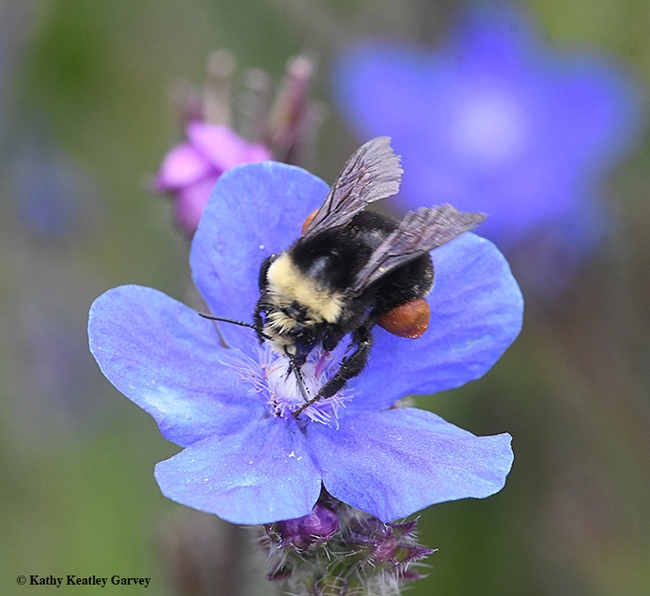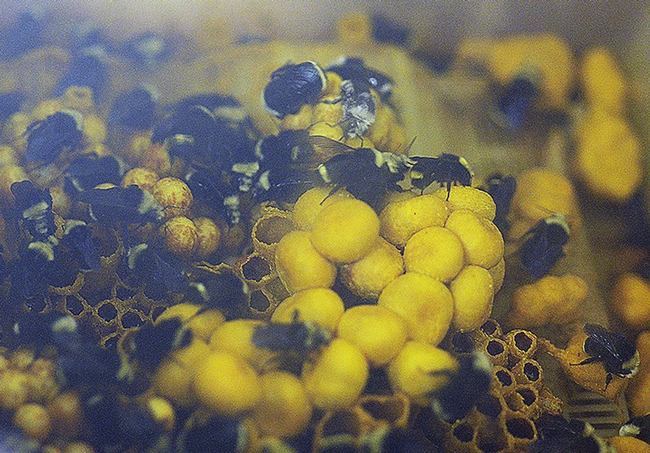- Author: Kathy Keatley Garvey
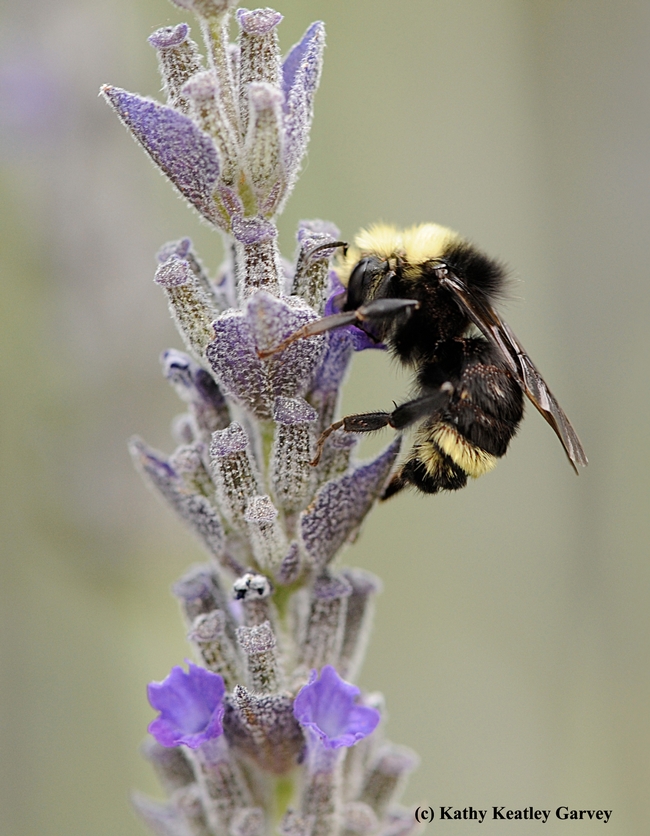
The United Nations designated May 20 as World Bee Day to raise awareness of the importance of pollinators, the threats they face and their contribution to sustainable development, according to its website.
It originated in 2018 when the government of Slovenia proposed that the United Nations declare May 20 as World Bee Day.
Why May 20? That was the day Anton Janša (1734-1773), a pioneer of modern apiculture, was born. "Janša came from a family of beekeepers in Slovenia, where beekeeping is an important agricultural activity with a long-standing tradition," relates Apimondia.
Today, however, let's pay tribute to the bumble bees. The late Robbin Thorp (1933-2019), UC Davis distinguished emeritus professor, UC Davis Department of Entomology and Nematology, used to point out there's only one bumble bee genus--Bombus--and that more than 250 species belong to this genus. California has 27 species of Bombus, according to Thorp in his 1983 published research, "Bumble Bees and Cuckoo Bumble Bees of California," written with colleagues Donald Horning Jr. and Lorry Dunning.
In his retirement, Thorp co-authored two books Bumble Bees of North America: An Identification Guide (Princeton University, 2014) and California Bees and Blooms: A Guide for Gardeners and Naturalists (Heyday, 2014).
Thorp, a member of the UC Davis entomology faculty for 30 years (1964-1994), continued his research, teaching and public service until his death in 2019 at age 85.
Franklin's bumble bee, Bombus franklini--a bee that he monitored for decades until his death in 2019--is now protected as an endangered species under the Endangered Species Act (ESA). It is feared extinct. Thorp, the last known person to see Franklin's bumble bee in its native habitat, spotted it in 2006 near Mt. Ashland. The bee inhabits--or did--a 13,300-square-mile area confined to five counties--Siskiyou and Trinity counties in California; and Jackson, Douglas and Josephine counties in Oregon. Its range may be the smallest range of any bumble bee species in North America, or even the world, he mused.
Today scientists are worried about the declining bumble bee population, a decline attributed to climate change, habitat loss, and pesticides. Bumble bees are especially known for their "buzz pollination" of such plants as tomatoes, peppers and cranberries. They help pollinate crops worth an estimated $3 billion in the United States alone.
"Due to threats including habitat loss, pesticide use and disease, sightings of the bee have declined by 89%, and it's disappeared completely from eight states. The decline of this once-common native bee is alarming and heartbreaking — and a harbinger of massive biodiversity loss across the country."--Center for Biological Diversity.
The dominant bumble bee species in California is the yellow-faced bumble bee, Bombus vosnesenskii. The Western bumble bee, B. occidentalis, used to be quite common. "It's one of four bumble bee species cleared by the state's Third Appellate District Court of Appeal for inclusion on California's endangered species list," according to a UC Riverside news story, published in July 2022.
Access the California Bumble Bee Atlas website to see how you can help. Meanwhile, how many species of bumble bees have you seen and photographed in California? Here are some of them.
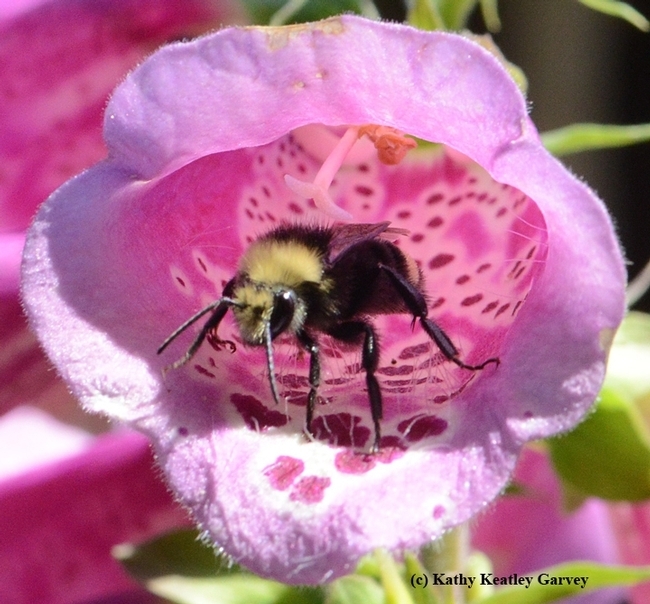
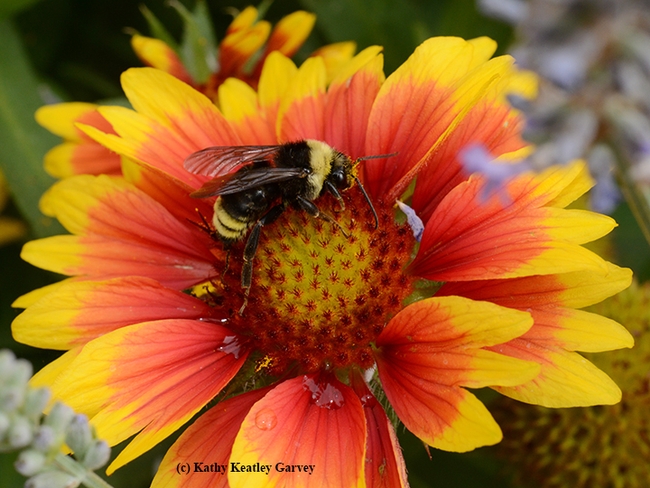
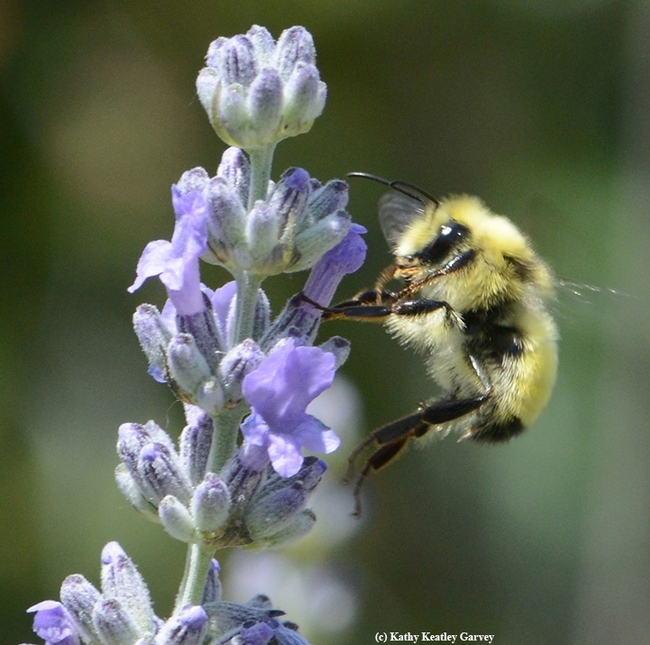
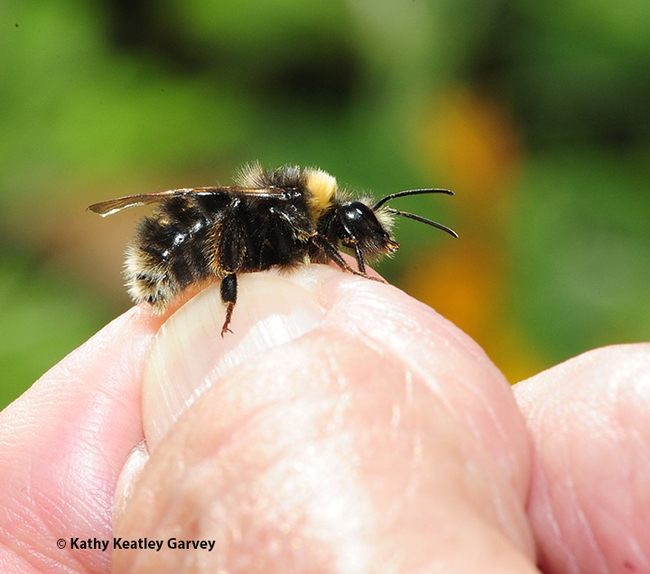
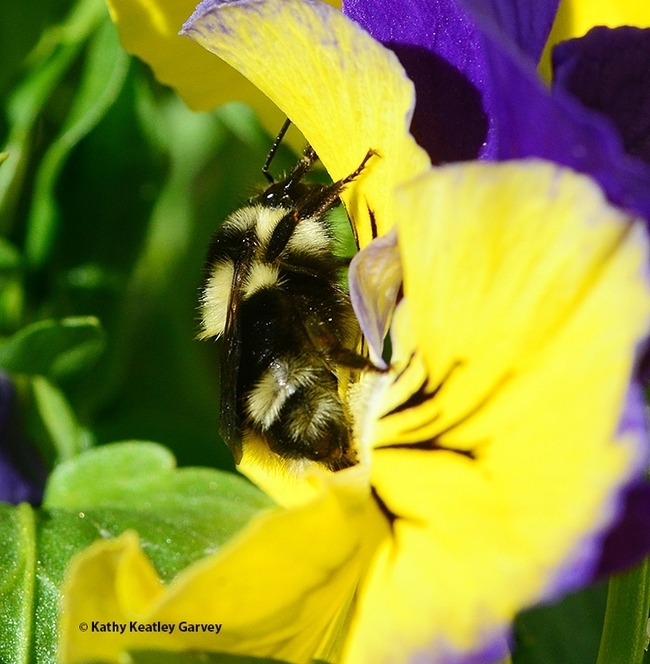
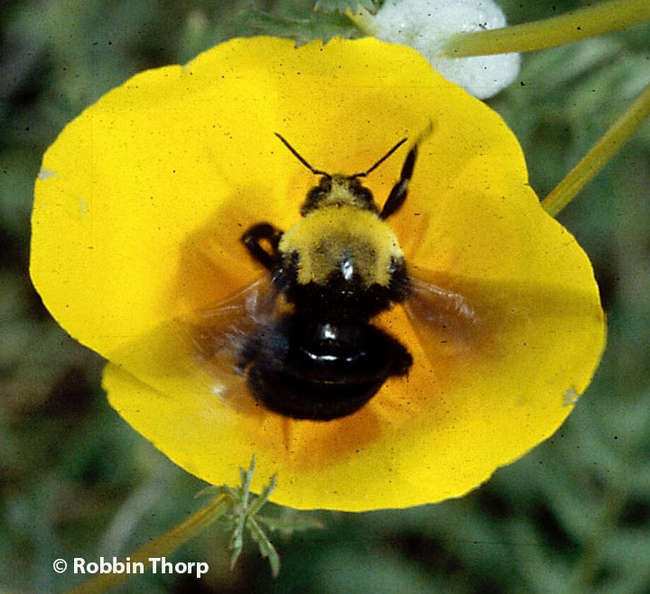
- Author: Kathy Keatley Garvey
Get ready...it's happening...the annual World Bee Day...
Monday, May 20 is World Bee Day, as declared by the United Nations "to raise awareness of the importance of pollinators, the threats they face, and their contribution to sustainable development."
"The goal is to strengthen measures aimed at protecting bees and other pollinators, which would significantly contribute to solving problems related to the global food supply and eliminate hunger in developing countries," the website points out. "We all depend on pollinators and it is, therefore, crucial to monitor their decline and halt the loss of biodiversity."
Lately we've been noticing multiple species of bumble bees in our pollinator garden in Vacaville. One of them appears to be Bombus bifarius.
The bumbles we've seen over the years in our pollinator garden--B. californicus, B. melanopygus, B.vosnesenskii and B. bifarius--especially like Coreopsis, a genus of flowering plants in the aster family, Asteraceae. It's also called tickseed.
Now that's not a good name for such a showy flower!
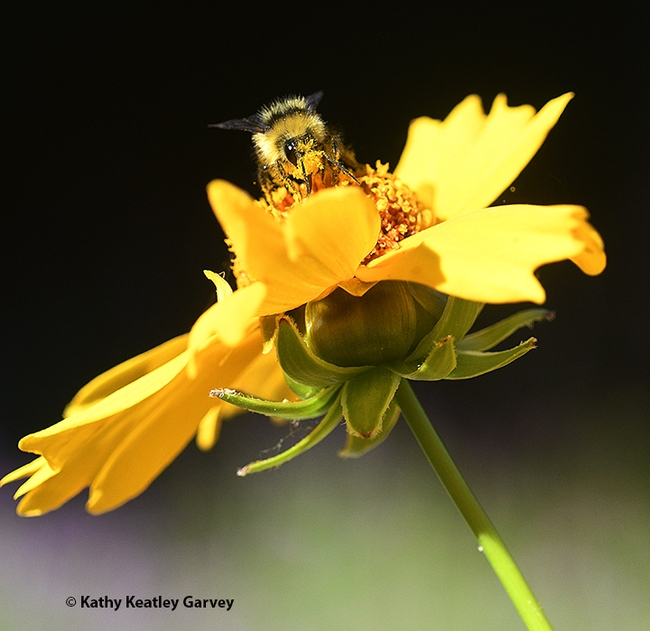
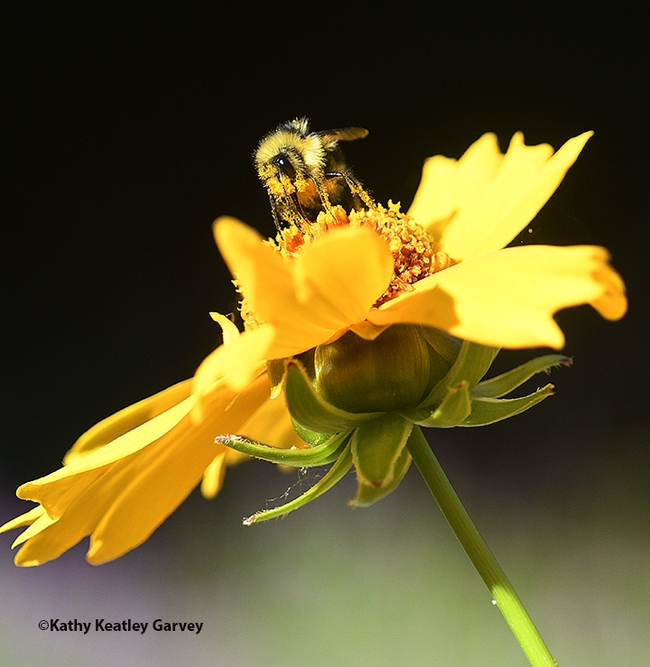
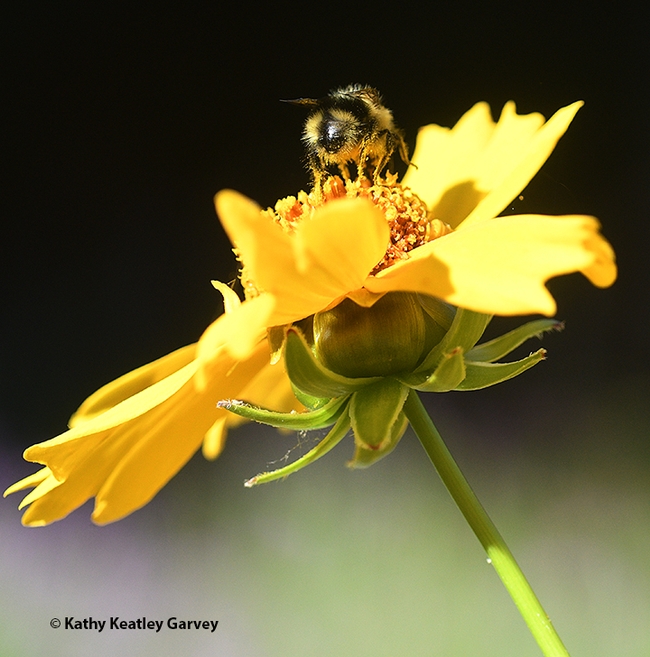
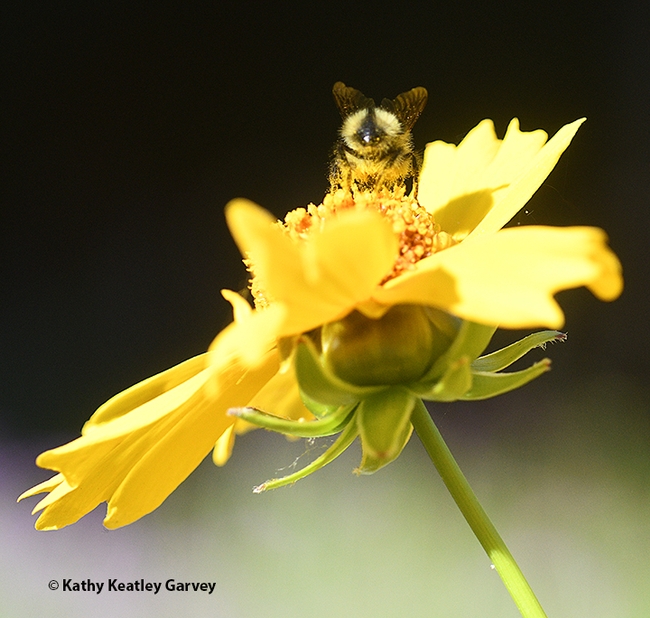
- Author: Kathy Keatley Garvey
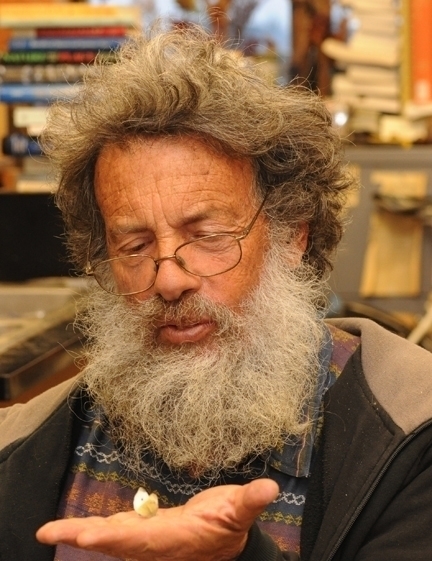
As of 4 p.m. today (Jan. 6), the two UC Davis "bug contests" underway--one, to collect the first cabbage white butterfly of the year in the three-county area of Sacramento, Yolo and Solano, and two, to photograph the first bumble bee of the year in the two-county area of Yolo and Solano--have yielded no winners.
UC Davis distinguished professor Art Shapiro, who sponsors the "Beer for a Butterfly" Contest (he'll trade you a pitcher of beer or its equivalent if you collect the first cabbage white butterfly, Pieris rapae), blames it on the rain. And more to come.
Shapiro was out looking for P. rapae today and "got wet and muddy but no bugs." He celebrated anyway with a beer. After all, today is his birthday!
And the rain?
"This may be the end of the world," he wrote in a group email (subject: "GLUB") on Jan. 5. "Periods of rain are expected every day through perhaps the 19th, with heavy rain and high winds on several occasions, beginning early next week. At least 6" more of rain can be expected in the Valley through Friday the 13th, with 10-20" on the west slopes of the Sierra and Coast Range. A megaflood scenario a la 1861-62 is unlikely-- but not out of the question. No discharges are yet expected into the Yolo Bypass, but that will probably change next week. Do not expect any butterfly records any time soon. Everybody stay safe and prepared for whatever may eventuate."
The barometer dropped to 29.54" on Wednesday morning, he added. "It's nowhere near a record but quite low."
Cabbage White Butterfly Contest
Shapiro, a member of the Department of Evolution and Ecology faculty, has sponsored the “Suds for a Bug” contest since 1972 to determine the butterfly's first flight of the year. He launched the contest as part of his long-term studies of butterfly life cycles and climate change.
P. rapae is emerging earlier and earlier as the regional climate has warmed, said Shapiro. "Since 1972, the first flight of the cabbage white butterfly has varied from Jan. 1 to Feb. 22, averaging about Jan. 20."
The contest rules include:
- It must be an adult (no caterpillars or pupae) and be captured outdoors.
- It must be brought in alive to the Department of Evolution and Ecology office, 2320 Storer Hall, UC Davis, during work hours, 8 a.m. to 5 p.m., Monday through Friday, with the full data (exact time, date and location of the capture) and the contact information of the collector (address, phone number and/or e-mail.) The receptionist will certify that it is alive and refrigerate it. (If it's collected on a weekend or holiday, it can be kept in the refrigerator for a few days--do not freeze it.)
- Shapiro is the sole judge.
The professor said P. rapae inhabits vacant lots, fields and gardens where its host plants, weedy mustards, grow. The male is white. The female is often slightly buffy; the "underside of the hindwing and apex of the forewing may be distinctly yellow and normally have a gray cast,” Shapiro said. “The black dots and apical spot on the upperside tend to be faint or even to disappear really early in the season.” In its caterpillar stage, it is a pest commonly called "cabbageworm."
Shapiro, who monitors butterfly populations in the field for more than 200 days of the year and posts information on his research website at http://butterfly.ucdavis.edu/, usually wins the contest. He has been defeated only four times and those were by UC Davis graduate students. Adam Porter won in 1983; Sherri Graves and Rick VanBuskirk each won in the late 1990s; and Jacob Montgomery in 2016. The first three were his own graduate students.
Shapiro is the author of A Field Guide to Butterflies of the San Francisco Bay and Sacramento Valley Regions, illustrated by Tim Manolis and published in 2007 by the University of California Press.
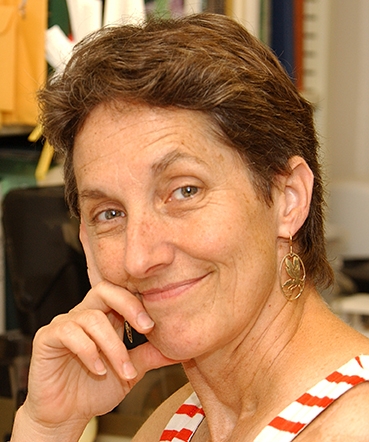
The Robbin Thorp Memorial First-Bumble Bee-of-the-Year Contest, the third annual, is sponsored by the Bohart Museum of Entomology. The first person to photograph a bumble bee in either Yolo or Solano and email the image to the sponsor, will receive a coffee cup designed with the endangered Franklin's bumble bee, the bee that Thorp monitored on the California-Oregon border for decades.
Contest coordinator Lynn Kimsey, director of the Bohart Museum and a UC Davis distinguished professor of entomology, said the image must be taken in the wild and emailed to bmuseum@ucdavis.edu, with the time, date and place. The image must be recognizable as a bumble bee.
The first bumble bees to emerge in this area are the black-tailed bumble bee, Bombus melanopygus, and the yellow-faced bumble bee, B. vosnesenskii.
The contest memorializes Professor Thorp (1933-2019), a global authority on bees and a UC Davis distinguished emeritus professor of entomology, who died June 7, 2019 at age 85. A 30-year member of the UC Davis faculty, he retired in 1994 but continued working until several weeks before his death. Every year he looked forward to seeing the first bumble bee in the area.
Two scientists shared the 2022 prize: UC Davis doctoral candidate Maureen Page of the Neal Williams lab, UC Davis Department of Entomology and Nematology (who now holds a Ph.D) and horticulturist Ellen Zagory, retired director of public horticulture for the UC Davis Arboretum and Public Garden. They each photographed a bumble bee foraging on manzanita (Arctostaphylos) in the 100-acre Arboretum at 2:30 p.m., Saturday, Jan. 1.
Page photographed a B. melanopygus, while Zagory captured an image B. vosnesenskii. Fittingly, they both knew and worked with Thorp, a tireless advocate of pollinator species protection and conservation and the co-author of Bumble Bees of North America: An Identification Guide (Princeton University, 2014) and California Bees and Blooms: A Guide for Gardeners and Naturalists (Heyday, 2014).
This marked the second consecutive win for a member of the Williams lab. Postdoctoral researcher Charlie Casey Nicholson of the Williams lab and the Elina Lastro Niño lab, won the 2021 contest by photographing a B. melanopygus at 3:10 p.m., Jan. 14 in a manzanita patch in the Arboretum.
Both Page and Nicholson are alumni of The Bee Course, which Thorp co-taught from 2002-2018. Page completed the course in 2018, and Nicholson in 2015. In July 2016, Page participated in a "Bumble Bee Blitz" organized by Thorp and the U. S. Fish and Wildlife Service on Mt. Ashland, where, she said, "we searched for Bombus franklini and Bombus occidentalis--two very rare west coast bee species. We unfortunately did not find B. franklini, which is now recognized as an endangered species under the Endangered Species Act.”
The prized coffee cup features an image of the bee specimen, photographed by Bohart scientist Brennen Dyer, now collections manager, and designed by UC Davis doctoral alumnus Fran Keller, a professor at Folsom Lake College. Previous winners are ineligible to win the prize.
The bumble bee contest originated as an impromptu contest in 2012 as a little rivalry between the late Professor Thorp and his "posse"--three of his bumble bee aficionados: Allan Jones, Gary Zamzow, and Kathy Keatley Garvey.
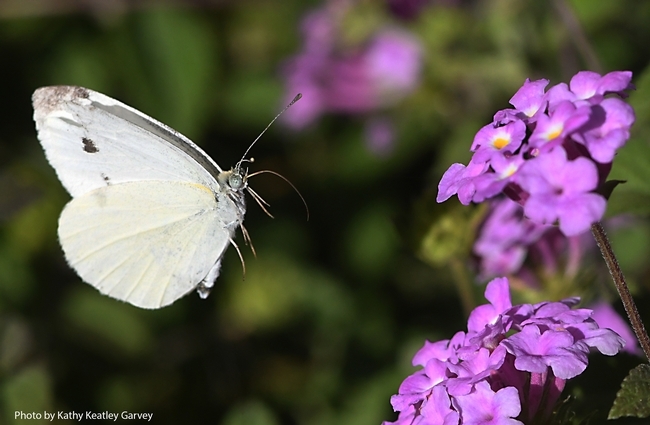
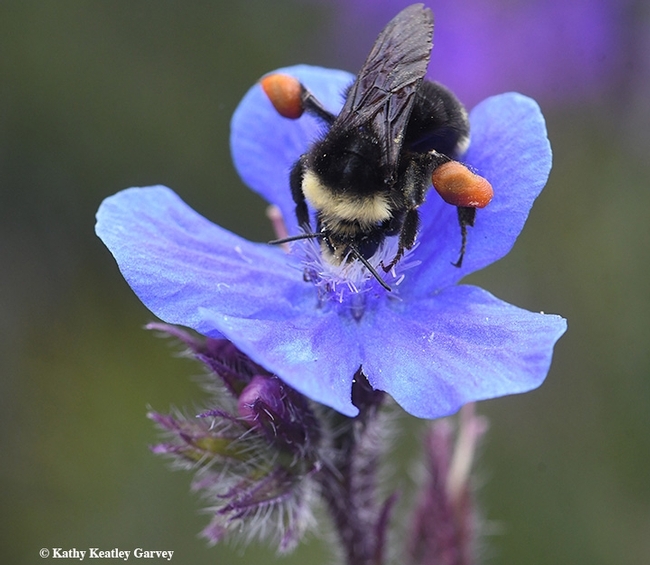
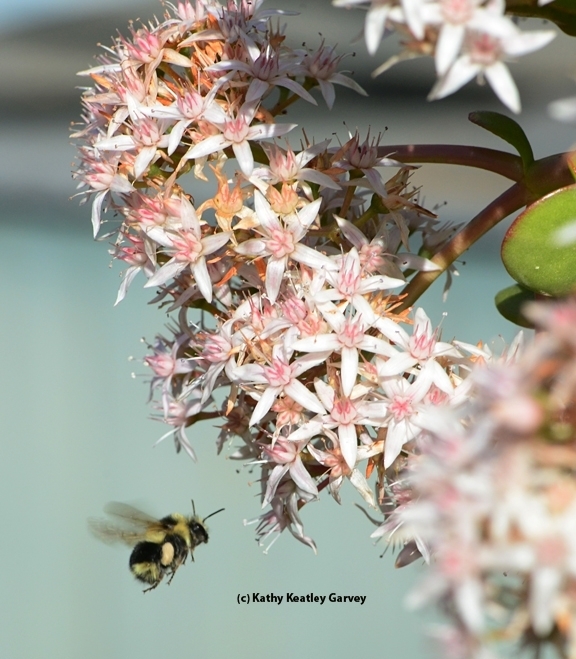
- Author: Kathy Keatley Garvey
How many different bumble bee species have you seen or photographed this year?
Have you seen the black-tailed bumble bee, Bombus melanopygus? It's the earliest to emerge in this area.
We photographed several B. melanopygus on Jan. 25 near downtown Benicia. Three were foraging on rosemary and one on a rose.
B. melanopygus is native to western North America and found from California to British Columbia and as far east as Idaho, it forages on manzanitas, wild lilacs, wild buckwheats, lupines, penstemons, clovers, and sages, among others.
Our little Bombus posse--Allan Jones, Gary Zamzow and Kim Chacon, all of Yolo County, and yours truly of Solano County--annually compete to find and photograph the first bumble bee of the year. As earlier mentioned, Jones won the 2020 contest--he photographed a B. melanopygus on Jan. 6 in the UC Davis Arboretum and Public Garden. No bumble bees are harmed in this contest. We don't poke 'em, prod 'em or pin 'em. We just take their picture, or rather, we capture their images.
The contest began in 2012 with our mentor, Robbin Thorp (1933-2019), distinguished emeritus professor of entomology, UC Davis Department of Entomology and Nematology. To memorialize him, the contest will now be known as Robbin Thorp Memorial Bumble Bee Contest and will sponsored by the Bohart Museum of Entomology, where the professor spent much of his time.
Thorp, a member of the UC Davis entomology faculty for 30 years (1964-1994), achieved emeritus status in 1994 but continued to engage in research, teaching and public service until a few weeks before his death. In 2014, during his retirement, he co-authored two books, Bumble Bees of North America: An Identification Guide California Bees and Blooms: A Guide for Gardeners and Naturalists. He co-taught The Bee Course from 2002 to 2019. This is an intensive nine-day workshop affiliated with the American Museum of Natural History and held annually at the Southwestern Research Station, Portal, Ariz. It's geared for conservation biologists, pollination ecologists, and other biologists who want to gain greater knowledge of the systematics and biology of bees.
The good professor was always concerned about the declining bumble bees, especially Franklin's bumble bee, found only in a small range in Southern Oregon and Northern California. He was a global authority on bumble bees and sounded the alarm to protect bumble bees, including this one. Lynn Kimsey, director of the Bohart Museum of Entomology and a UC Davis professor, fears it is extinct. No one has seen it since Thorp spotted it in 2006. (See Bug Squad)
Meanwhile, keep an eye out for bumble bees, and do what you can to protect them (plant flowers that they prefer and don't use pesticides). Robbin Thorp would have liked that.
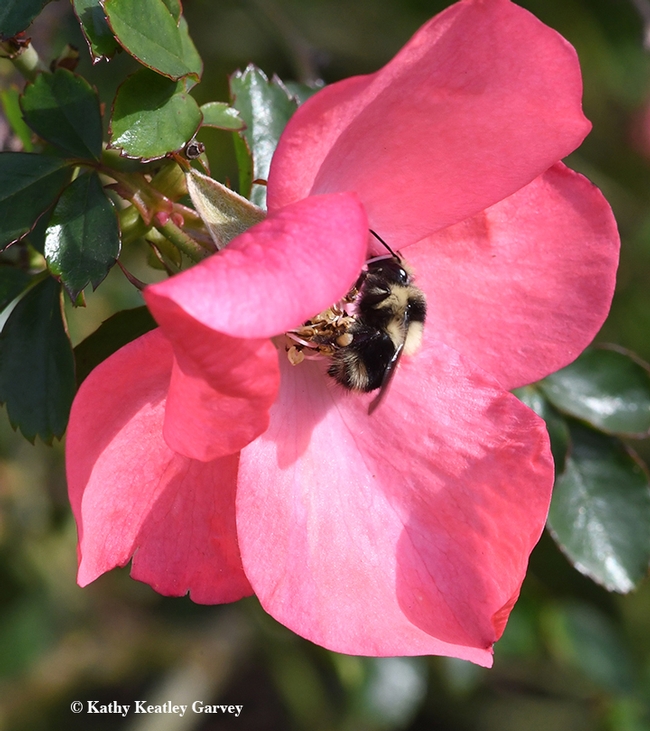
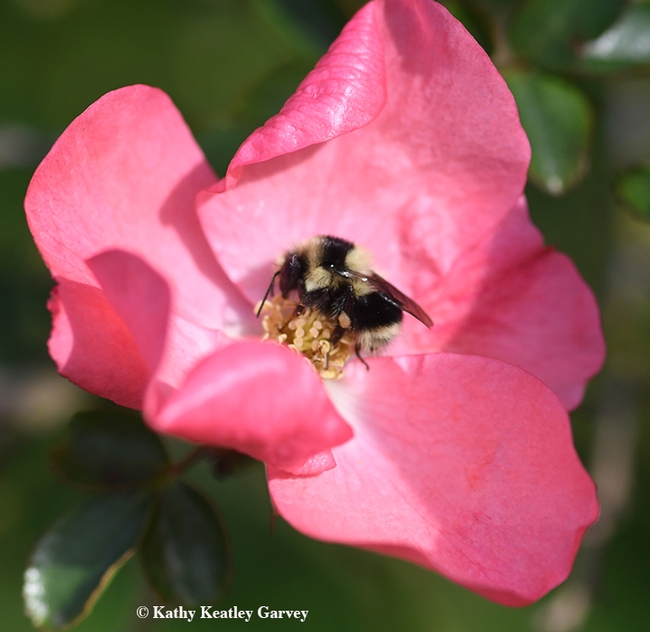
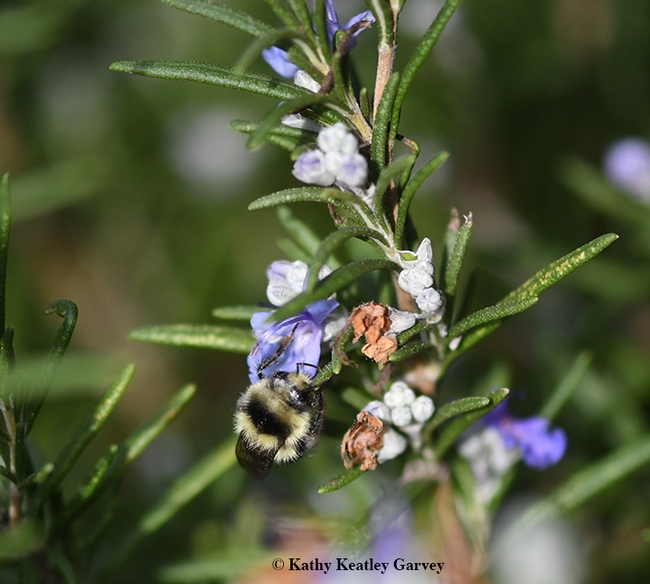
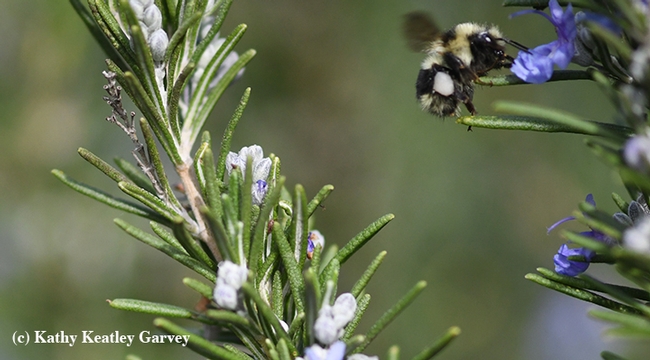
- Author: Kathy Keatley Garvey
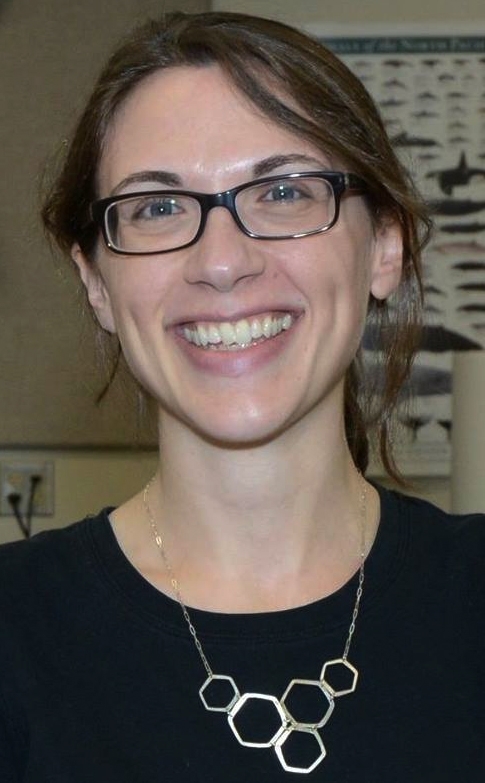
Especially when it comes to bumble bee colonies.
Postdoctoral scholar Rosemary Malfi of the Neal Williams lab, University of California, Davis, will speak on “Timing Is Everything: Bumble Bee Colony Performance in Response to Seasonal Variation in Resources” at 4:10 p.m., Wednesday, May 30 in 122 Briggs Hall.
“Wild bee populations are considered to be strongly regulated by the availability of flowering resources on which they rely for food, that is, pollen and nectar, yet we lack robust, experimental data demonstrating the mechanistic connections between the floral resource environment and bee population health," Malfi says. "The temporal distribution of resources, in particular, is an understudied but potentially highly influential aspect of habitat quality affecting bees. Bumble bees (Bombus spp.) are annual, euosocial insect with high conservation value. Because their colonies must grow for several weeks before reproducing the timing of within-season resource abundance and scarcity is especially likely to impact their demographic performance."
At her seminar, Malfi will describe her postdoctoral work here at UC Davis, "in which we investigated the importance of the timing of floral resource abundance for bumble bee (Bombus vosnesenkii) colony success through two large field experiments involving the manipulation of the food environment that colonies experienced. In the first study, we assessed how differences in the resource environment early in colony development affected both individual and colony level traits across the season using radio-frequency technology (RFID) and mark recapture methods. In the second study, we determine whether a pulse of food resources early in development, compared to a pulse delivered later during the 'pre-reproductive' phase, has a greater or similar impact on the peak size and reproduction of bumble bee colonies. We use a null method of exponential colony growth to explore whether resource pulses have persistent effects on colony growth after the pule itself has disappeared. Together these studies demonstrate that resource abundance early in development is critical for the success of bumble bee colonies, and this populations."
A native of Philadelphia, Rosemary received her bachelor of arts degree from Bryn Mawr College, an all-women's liberal arts school in the greater metro area, and worked two years at the Academy of Natural Sciences of Philadelphia as a lab manager for the in-house Patrick Center for Environmental Research.
Mali holds a doctorate in environmental science (ecology) from the University of Virginia in 2015 , studying with major professor T'ai Roulston. She focused her doctoral research on the influence that flower (i.e. food) availability and parasitism have on bumble bee (Bombus spp.) population dynamics, and how risks associated with these factors vary among species within a community. In her work, integrating field observations, parasite analysis, colony manipulations, the use of radio frequency technology, and simulation modeling, she investigated these sources of environmental influence independently and interactively through studies that focus on bumble bee populations and environmental risks present in northern Virginia.
Among the bumble bee parasites Malfi has studied: Nosema bombi, a pathogenic fungus implicated in "the precipitous and rapid decline of several bumble bee species across North America." During her graduate studies, she became especially interested in the interaction between bumble bees and one of their parasitoids, the conopid fly. "Although the basic biology of this interaction has been described," she says, "little is currently known about the ecology of this host-parasitoid relationship, particularly in North America." Malfi discussed her work on the conopid fly at the January 2016 open house of the Bohart Museum of Entomology, UC Davis.
Malfi's postdoctoral position at UC Davis ends in September, and then she will be moving to Massachusetts with her family. She will be working in the lab of Lynn Adler at the University of Massachusetts, Amherst, to carry out research on the influence of diet on bumble bee colony development and health.
Career plans? "For now, my career plans are to continue pursuing research on wild bee population health," she says. "In my next position at UMass Amherst, I'll be focusing on how the diet of bumble bees may mediate the influence of pathogenic parasites on individual- and colony-level performance."
